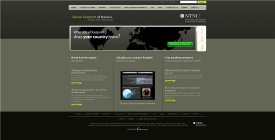Mar 8 2010
How much carbon does your country emit - and where does it come from? Norwegian University of Science and Technology (NTNU) Professor Edgar Hertwich and colleague Glen Peters wanted to know the answer to that question -- and created a website to do so. Now, the article describing this website has won an Editor's Choice Award from a leading American scientific journal, Environmental Science and Technology.
 Screenshot of "Carbon Footprint of Nations" website.
Screenshot of "Carbon Footprint of Nations" website.
Hertwich, who is head of NTNU's popular and internationally recognized Industrial Ecology Programme in the Department of Energy and Process Engineering, co-authored the paper "Carbon Footprint of Nations: A Global, Trade-Linked Analysis" with Peters, who is from the Centre for International Climate and Environment Research (CICERO) in Oslo.
The paper describes "Carbon Footprint of Nations", the website created by Hertwich and Peters, where users can check the importance of different consumption categories for their nations, particularly for imports and exports. The paper was originally published in the June 15 edition of Environmental Science and Technology and details the greenhouse gas emissions associated with the final consumption of goods from 73 nations and 14 world regions.
The site also describes how emissions vary with consumption, and the consumption categories that are responsible. The picture that emerges is that there is a clear relationship between emissions and overall consumer spending, and that greenhouse gas emissions rise about 70% with each doubling of consumer spending. Increased consumption increases the share of emissions from transport and consumer goods and decreases the proportion of emissions that can be attributed to food. The study also shows that the emissions related to production of goods that we import are important. “This illustrates the danger of shifting emissions related to our own consumption from in-country to the developing world,” Hertwich notes.
Hertwich and Peter's paper was selected as the best policy paper published by ES&T in 2009, and was selected from among 80 papers nominated by the journal's editors. ES&T is published by the American Chemical Society and features nearly 1500 scientific articles each year. The announcement was made official on Monday, March 8.